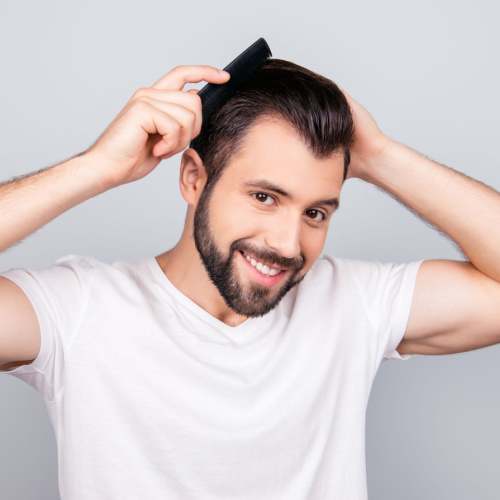What Causes Hair Loss?
Everyday shedding is a normal occurrence. However, if you experience persistent balding or thinning hair, there could be several contributing factors. Male pattern baldness is the most common cause of hair loss. Other issues like thyroid disease and Polycystic Ovarian Syndrome (PCOS) can also negatively affect hair growth.
You may also experience hair loss due to the following issues.
- Alopecia areata
- Stress
- Telogen effluvium (TE)
- Traction alopecia
- Lichen planus
- Lichen planopilaris
- Dermatitis
- Alopecia totalis
- Melanoma
- Auto-immune conditions
The Best Hair Restoration Treatments in River Vale, NJ
Everyone experiences hair loss differently. Finding the right hair restoration solution for you could mean trying medications for regrowth or more permanent options like hair transplant surgeries.
Medications for Natural Hair Growth
Suppose you’re not ready to commit to a surgical hair transplantation procedure. In that case, medications like Minoxidil and Finasteride could be a great starting point to stimulate regrowth in areas where you’re experiencing hair loss.
Minoxidil (Rogaine) can be prescribed as a tablet, but it’s most commonly used as a topical ointment. This medication works by widening your blood vessels to improve circulation and encourage hair regrowth. Finasteride (Propecia or Proscar) is a pill that blocks testosterone from turning into dihydrotestosterone, which can cause hair loss.
Your hair loss will resume if you stop taking either medication, so it’s important to stay consistent if you want to maintain your hair.
Hair Replacement Surgery and Procedures
If medications aren’t an option or don’t work for you, several surgical and nonsurgical procedures can help you achieve your desired results. Identifying the best treatment options for you depends on the extent of your hair loss, your health history, and your hair specialist’s recommendation.
Follicular Unit Transplantation: (FUT)
Follicular Unit Transplantation (FUT) surgery is performed by a hair surgeon who removes a strip of healthy hair follicles from the back of your head and transplants them to balding or thinning areas. The transplanted hair will then grow as normal so that you have a fuller head of hair. This procedure is also known as “hair plugs” or the “strip method” and typically takes anywhere from four to eight hours.
Follicular Unit Extraction: (FUE)
Follicular Unit Extraction (FUE) hair transplant is different from FUT in that instead of harvesting one larger unit of hair, individual hair follicles are extracted and then transplanted. FUEs can be done in more than one hair transplant session, depending on your goals. This procedure is often appealing because of less scarring and more natural-looking results.
Facial Hair Transplants
If you want a thicker beard, more symmetrical eyebrows, a fuller mustache or goatee, facial hair transplants can help you achieve your desired results. Like with the FUE procedure, your hair surgeon will remove follicles from a donor site and transplant them onto areas of your face where you’d like to see growth.
Platelet-Rich Plasma: PRP Therapy
Platelet-Rich Plasma (PRP) therapy involves drawing your blood, processing it, and injecting your platelets into the damaged or thinning areas. This therapy can expedite the recovery process after another hair procedure by promoting healing, or it can be used on its own to encourage new growth.
Scalp Micropigmentation (SMP)
If you’ve been tattooed before, SMP is very similar. While the microneedling tool used in SMP doesn’t penetrate the skin as deeply as a traditional tattoo, it injects pigment into your scalp to create the appearance of a full head of hair. This technique is especially useful for those who wear their hair short, but it can also help to create a fuller-looking hairline.
Female Hair Restoration
We’re proud to offer inclusive hair restoration services to all our clients and can help you determine the right kind of treatment sessions to achieve your desired results. We’ll review all of your options for female hair restoration services in a thorough consultation.
PDO Threads
PDO Threads involve the use of slowly dissolving sutures to promote hair growth. These sutures oxygenate the scalp, improve blood flow, contribute to collagen regeneration, hyaluronic acid, and elastin production. This process can be done with another hair transplant and stimulates your body’s platelet response to encourage new hair growth for over six months.
Stem Cell Grafting
Stem Cell Grafting is a procedure that involves extracting adult stem cells from tissue that’s harvested from the back of the head. These stem cells are then injected into areas with damaged hair follicles to establish healing and grow hair.

